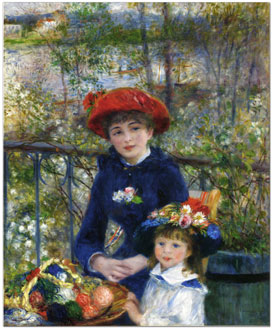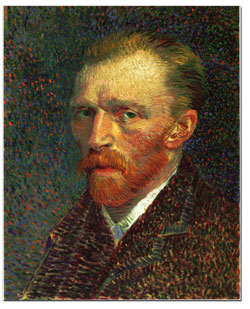|
| ||||
| A soiree with the Impressionists
by Jules Masterjohn Degas, Monet, Morisot, Cézanne, Gauguin, Van Gogh, Toulouse-Lautrec and others were all in the room. I could hardly contain my excitement being in the presence of these early avant garde artists. Often, I have wondered what it would have been like to be alive during the last half of the 19th century, when a handful of French artists forged ahead into new artistic territory. These intrepid few changed not only the “look” of painting but the role of the visual artist within culture. My encounter with the once-edgy colors and brushstrokes of the Impressionists didn’t take place in France where they were created. Nor did it take place in their current home in Chicago. No, I traveled a much shorter distance to commune with these well-known paintings. Fort Worth, Texas, and more specifically, the Kimbell Art Museum, is the temporary venue for these 90 or so paintings. “The Impressionists: Master Paintings from the Art Institute of Chicago” is a user-friendly art history lesson. The informative, self-guided audio tour enabled some of my favorite paintings to spring vividly into the present. The sounds of horses’ hooves while encountering Gustave Caillebotte’s “Paris Street; Rainy Day” and hearing piano music while standing in front of “Woman at the Piano” by Pierre-Auguste Renoir, offered additional context to the viewing experience. The efforts of the museum professionals to create accessible information were well received: the Kimbell was filled at 10 a.m. on a Thursday morning. Much has been written on the contributions of the Impressionist painters. In the words of Malcolm Warner, acting director of the Kimbell Art Museum, “Among them, they reinvented painting, taking color and brushwork into new realms of beauty and artistic adventure. They were painters of modern life who created a more complete and delightful picture of the world in which they lived than any artists before or since.” Through their innovations in approach and technique, the Impressionist painters liberated French artists from slavishly following the conventions that had a stranglehold on the profession for almost 200 years. One example of this is seen through their use of one of the basic building blocks of painting – the brushstroke. Viewing an Impressionist work at a museum – versus in a reproduced form – is pure joy. First-hand, the individuality of each stroke is tangible. Also revealed are the painter’s technical decisions regarding the amount of paint on the brush and the pressure used to apply it. Each stroke is a record of the artist’s mind and hand, and communicates through the centuries. Tears of empathy moistened my eyes as I recognized the despair in the eyes of Vincent Van Gogh in his 1887 painting, “Self-Portrait.” These artists recorded their truths with each and every stroke. This was most obviously demonstrated through the work of Renoir. Though I have seen many dozens of his paintings of Parisian society reproduced either in books or online, and a mere few first hand, laying my eyes on the dozen in this exhibition was exhilarating.
I found a gentleness in Renoir’s approach to portraiture that radiates with respect for his sitters, an aspect of his paintings that I had never noticed before. In “Two Sisters,” his soft, feathery brushstrokes are like caresses that depict each of his subjects lovingly. The near realistic style he used to portray the cheeks and hands of his models is completely different in temperament than the paint application used to create the landscape around them. The river and trees behind the two dissolve into individuated strokes of colors where representation nearly loses its foothold. There is no pretense of painterly concern in the background, and gone is Renoir’s allegiance to realism except for the color. Another painter whose work was instructive to see in the exhibition was Henri de Toulouse-Lautrec. Like Renoir, he was interested in depicting Parisian social life, though not the light-filled scenes of social gatherings in parks and along the Seine River. Dark in palette and sentiment, Toulouse-Lautrec’s paintings rarely depict the light of day, instead chronicling the nightlife in the cafés, cabarets and brothels of Paris. His most famous painting, “At the Moulin Rouge,” was a total treat to see. Having looked at this painting numerous times in reproduction form, I had noticed the uneven quality of his paint application. Some areas were sketched in monochromatic hues while others were thoroughly rendered in vibrant paint. For the first time while standing in front it, I understood why Toulouse-Lautrec might have chosen this dual approach. By creating this visual discrepancy, the viewer’s eye moves around the canvas following his sketchy lines, looking for a resting place. The saturated colors and solid forms of the “finished” subjects fulfill this purpose. Toulouse-Lautrec reminds us that master artists make conscious choices with everything stroke. Perhaps not an epiphany equivalent to finding an effortless solution to global warming, it was a meaningful discovery to simply notice what had escaped me so many times before. In relationship to carbon footprints and art adventures, if you do make the painless14-hour drive to Fort Worth to see this amazing collection on display through Nov. 2, bring along three art buddies to share the emission load! • For more information on “The Impressionists: Master Paintings from the Art Institute of Chicago,” visit www.kimbellart.org . Locally, a deeper look into the seamy world of Toulouse-Lautrec can be found in the documentary film, “Toulouse-Lautrec and Montmartre” available at the Durango Public Library.
|
In this week's issue...
- May 15, 2025
- End of the trail
Despite tariff pause, Colorado bike company can’t hang on through supply chain chaos
- May 8, 2025
- Shared pain
Dismal trend highlights need to cut usage in Upper Basin, too
- April 24, 2025
- A tale of two bills
Nuclear gets all the hype, but optimizing infrastructure will have bigger impact



